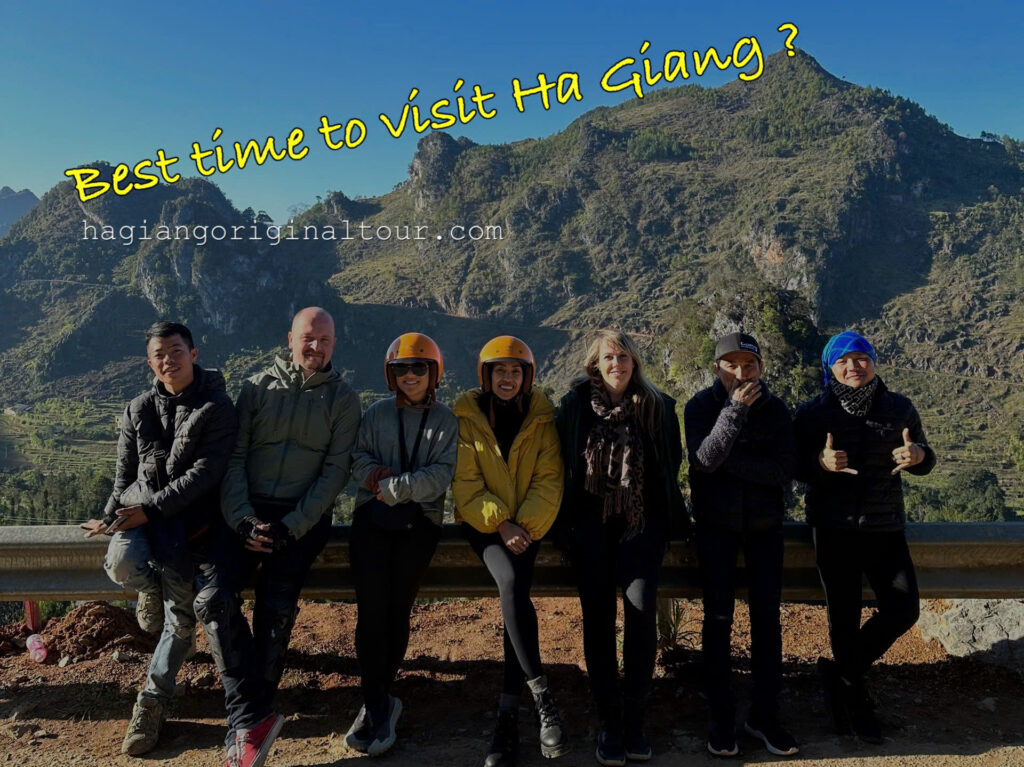The Best Time to Visit Ha Giang – A Complete Seasonal Travel Guide

The Best Time to Visit Ha Giang
Ha Giang, the northernmost province of Vietnam, is a dream destination for adventurers and culture lovers. Known for its winding mountain passes, stunning limestone peaks, and ethnic diversity, Ha Giang offers a raw and authentic travel experience. But when is the best time to visit? Let’s explore what each season has to offer and help you choose the ideal time to experience Ha Giang at its finest.
Table of Contents
Spring (January – March): Blooming Flowers & Festive Spirit
Colorful Blossoms Across the Mountains
From late January to March, Ha Giang transforms into a floral paradise. Peach blossoms, plum flowers, and mustard fields burst into bloom, covering the hillsides and valleys in shades of white, pink, and yellow. The weather is generally dry, cool, and sunny, with average temperatures around 17–20°C – perfect for trekking, motorbiking, and photography.
Ethnic New Year Festivals
This season coincides with Tet (Vietnamese Lunar New Year), a time when ethnic minorities like the Hmong, Dao, and Tay hold vibrant traditional festivals. Expect to see fire dances, flute performances, and colorful traditional costumes. Visiting Ha Giang during this time offers a deep cultural immersion into highland customs.
Early Summer (April – June): Waterfall Season & Rice Fields Mirror the Sky
Pleasant Weather, Blue Skies
April and early May are considered ideal for sightseeing. The temperature ranges between 24–30°C, and the sky is typically clear. Rain begins in late May but usually falls in short showers, keeping the landscape fresh and green.
Start of the Water-Pouring Season
This is when farmers in Hoang Su Phi and Quan Ba begin flooding the terraced rice fields to prepare for planting. As sunlight reflects on the water-filled terraces, they resemble vast natural mirrors – a surreal sight for photographers and nature lovers alike.
Powerful Waterfalls & Lush Caves
With the first rains, waterfalls like Do Quyen and streams near Lung Thau become more active and majestic. Caves remain cool and accessible for light adventure trips, making this season great for nature-based activities.
Autumn (September – November): Ha Giang at Its Best
Golden Rice Terraces
Late September through early October is rice harvest season. Terraced fields in places like Hoang Su Phi and Y Ty turn golden yellow, creating one of Vietnam’s most iconic landscapes.
Buckwheat Flower Season
From late October to mid-November, Ha Giang bursts into bloom again – this time with buckwheat flowers, a gentle pinkish-purple flower that carpets the hillsides. The Buckwheat Flower Festival is held annually, showcasing ethnic music, dance, local food, and traditional games.
Perfect Weather for Travel
Autumn in Ha Giang means dry days, cool air (18–25°C), and clear skies – ideal for motorbike road trips through the Ha Giang Loop, trekking, or capturing breathtaking landscapes.
If you’re looking for the best time to visit Ha Giang, this is it!
Winter (December – February): Misty Mountains & Local Tranquility
Mysterious and Serene
Winter brings cold weather (as low as 5–7°C in higher altitudes like Dong Van) and a mysterious charm to Ha Giang. Fog rolls over the limestone peaks and valleys, turning the landscape into a dreamy canvas.
Yellow Mustard Flowers
In December, the golden mustard flowers bloom once again, especially in Pho Bang and Sung La. This season sees fewer tourists, offering a more peaceful, personal connection with local life.
So… What Is the Best Time to Visit Ha Giang?
After exploring all seasons, there’s a clear winner:
The Best Time to Visit Ha Giang: Late September to Mid-November
Here’s why:
- ✅ Mild, dry weather (18–25°C), ideal for outdoor adventures.
- ✅ Nature at its peak with golden rice fields and blooming buckwheat flowers.
- ✅ Smooth roads and safe riding – minimal rainfall.
- ✅ Vibrant festivals: especially the Buckwheat Flower Festival celebrating local culture.
🏆 If you have to choose just one time to go, late September to mid-November offers the perfect balance of scenery, weather, and cultural experiences.
Month-by-Month Summary
| Time | Highlights | Best For |
|---|---|---|
| Jan – Mar | Peach blossoms, Spring festivals | Culture lovers, photographers |
| Apr – Jun | Water-pouring season, waterfalls | Landscape photography, off-peak travel |
| Sep – Nov | Rice harvest, buckwheat blossoms | Best overall: scenery + festivals |
| Dec – Feb | Misty mountains, mustard flowers | Quiet retreats, cultural immersion |
Travel Tips for Ha Giang
- 🛵 Getting there: Take a night bus from Hanoi (8–9 hours), then rent a motorbike in Ha Giang city.\n- 👕 What to pack: Warm clothes (especially in winter), rain gear, sunscreen, gloves.\n- 🏡 Accommodation: Book early during festivals or harvest season; consider staying in homestays for authentic experiences.\n- 🧭 Respect local customs: Dress modestly, ask before taking photos, support local crafts and food.\n- 📱 Weather check: Always check forecasts—rain and fog can change road conditions quickly.
Conclusion: Every Season Has Its Magic
Ha Giang is stunning year-round, and your best time to visit depends on your preferences:
- 💐 Love flowers and festivals? Go in Spring (Jan–Mar).\n- 💧 Want surreal terraced landscapes? Try April–May.\n- 🌾 Seeking the best scenery and culture? Don’t miss September–November.\n- ❄️ Prefer peace and cool air? Winter (Dec–Feb) is for you.
No matter when you go, Ha Giang promises an unforgettable journey through one of Vietnam’s most breathtaking and culturally rich regions.
If you’re also looking for a memorable trip to Sapa, check out our Sapa tours here.
Have questions or want to plan your trip? Feel free to contact us here.
